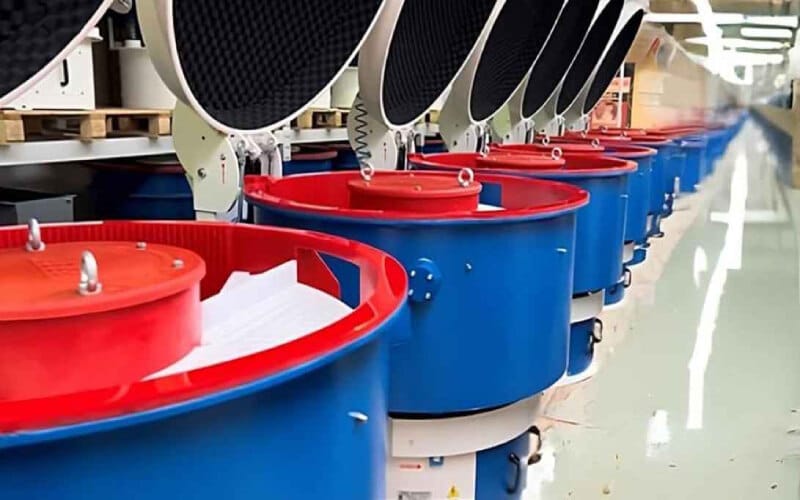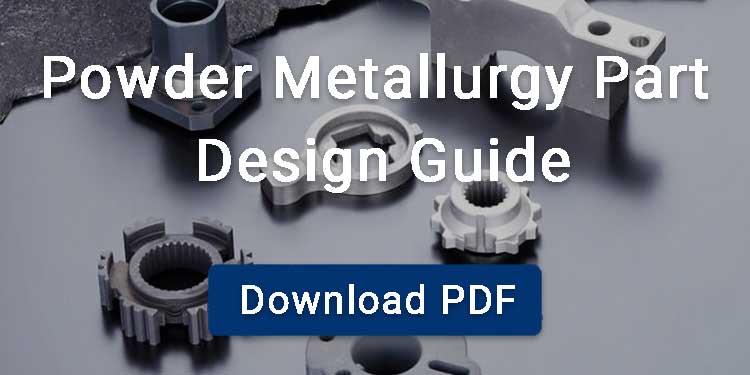Vibratory finishing is a mass finishing process that improves the surface finish of mechanical parts by removing burrs, sharp edges, rust, and other imperfections. The parts are placed in a vibrating container filled with abrasive media, water, and chemical compounds, where continuous movement polishes and cleans the surfaces.
Contents
Vibratory Finishing Process
Choosing the Abrasive Media
The first and most crucial step in the vibratory finishing process is choosing the abrasive media and compound, which significantly depends on the components you are going to treat. For example ceramic media is considered ideal for general deburring of hard metals.
Selecting the Compounds
After finalizing the media, the vibratory finishing compound is selected based on the components; either it needs only cleaning compound or it needs abrasive and rust-preventing compounds as well. For example:
- Plastic media needs cleaning compound only.
- Ceramic media requires occasional abrasive compound runs to remove glazing.
- Heavy abrasive compounds should not use recirculated water to avoid contamination.
Setting the Component Media Ratio
Here is a breakdown of how this ratio is decided:
| Media-to-Parts Ratio | Use Case | Effect on Process |
|---|---|---|
| 1:1 | When surface appearance is not critical | High chance of part-on-part contact; may cause scratches |
| 3:1 | Standard ratio for general applications | Provides balanced protection, good surface finish, and efficient operation |
| 4:1 | Machines with internal separation systems | Ensures smooth separation and prevents part damage during unloading |
| 8:1 or higher | Delicate or sensitive parts | Minimizes contact between parts; reduces risk of surface defects or deformation |
Loading the Components to the Machine
After choosing the right ratio, the compounds and the components are loaded into the vibratory machine Trough or tub. The load should be kept between 75–90% for efficient performance.
Running the Vibratory Finishing Equipment
After the compound is loaded, the parameters of the machine are set, and the process is started such as:
- Amplitude: It is normally set between 4mm to 5mm.
- Frequency: It is usually 700 vibrations per minute or approximately 28.3 Hz
For bulky or fragile parts, typically, fast vibratory speeds with low amplitude are used to reduce stress on the components. Fast speeds and small amplitudes are set to get surface finishes, making them suitable for polishing and internal deburring.
Finishing and Separating
This is the last and final step in metal vibratory finishing, where the separation and unloading are done once the desired finish is achieved. The parts are separated from the media using screens or internal separators.
Vibratory Finishing System Configurations
Vibratory finishing is configured in two ways here:
Batch System
In a batch vibratory finishing system, a fixed group of parts is loaded into the machine along with the chosen media, compound, and water. Here, the machine processes all the components simultaneously. Once the desired finish is achieved, the entire batch is unloaded and separated, and then the machine is prepared for the next cycle.
Continuous System
In a continuous vibratory finishing system, the machine operates on a flow-through basis. Here, parts are fed into the machine at one end and gradually move through the media mass to exit at the discharge end in a finished state. This system is often integrated into automated production lines.
Vibratory Finishing Media
Ceramic Media
It is the most commonly used type in vibratory finishing. It’s made from a mixture of abrasive materials like aluminum oxide and clay, then fired at high temperatures. It provides aggressive cutting action, making it ideal for deburring and deflashing.
Plastic Media
Since plastic media is lightweight and softer than ceramic, it is suitable for aluminum, brass, zinc, and other soft metals. It produces smooth finishes with minimal part damage.
Steel Media
If vibratory finishing is done for burnishing, polishing and strengthening of components, steel media is used. It is great for hard metals and non-abrasive operations.
Organic Media
Organic media like corn cob and walnut shell are used for dry polishing, light deburring, and drying operations. These media absorb oils and residues without altering the surface geometry.
Applications of Vibratory Finishing
Deburring
Vibratory finishing is used to remove sharp edges, burrs, and flash from powder metal parts, machined parts, or cast parts.

Polishing
Vibratory finishing also enhances the surface finish by smoothing and brightening the part. It has been found to be applicable in the jewelry and automotive industry for aesthetic or functional improvement of metal components.
Cleaning
This process is also used for removing dirt, oil, rust, or scale from parts, preparing them for assembly or further processing.
Surface Preparation Before Coating
Vibratory finishing helps create a clean, textured surface. This improves the adhesion of paint, plating, or other coatings.
Edge Radiusing
The product of vibratory finishing rounds off sharp edges to reduce stress concentration and improve part strength and handling safety.
Types of Vibratory Finishing Machines
Vibratory Bowl Finishing Machines
These vibratory finishing equipment is usually circular or oval-shaped and considered ideal for general-purpose mass finishing. In this machine, the loading chamber is like a bowl that vibrates to create a rolling action. This machine is considered suitable for deburring, polishing, and cleaning small to medium-sized components.

Vibratory Tub Finishing Machines
These machines feature a straight or U-shaped tub. This U-shaped tube makes them suitable for long, large, or delicate parts that can get damaged in a bowl
Dual-Action or Centrifugal Vibratory Machines
In these machines, vibratory and centrifugal forces combine to deliver aggressive material removal in shorter cycle times. Such vibratory machines are used for treating hard metals to remove the heavy burr and for faster processing is required.
Advantages and Limitations of Vibratory Finishing
Advantages of Vibratory Finishing
- Uniform Surface Finishing: Vibratory finishing delivers consistent results across all parts. It works effectively even on complex geometries and internal features.
- Mass Processing Capability: It can finish large volumes of parts in a single cycle. This results in reduced labor and processing time.
- Versatile Applications: It is considered suitable for deburring, polishing, cleaning, and surface preparation on various materials, including metals, plastics, and ceramics.
- Minimal Part Damage: Since the method includes controlled vibration and media action, it reduces the risk of part deformation or damage when working with delicate components.
- Automation Compatible: It can be integrated with batch or continuous systems for semi- or fully automated production lines.
Limitations of Vibratory Finishing
- Limited Material Removal: It is not suitable for heavy stock removal or sharp burrs on thick parts.
- Media Lodging Risk: Vibratory machines may require manual cleaning because small holes, slots, or undercuts in parts can trap media.
- Noise and Vibration: The machines generate noticeable vibration and noise, often requiring isolation pads and safety enclosures.
Tumbling Vs Vibratory Finishing
| Parameter | Tumbling Finishing | Vibratory Finishing |
|---|---|---|
| Motion Type | Rotational (barrel rotation) | Vibrational (oscillating bowl or tub) |
| Cycle Time | Longer | Shorter; typically 30–60 minutes for deburring |
| Part Movement | Parts tumble over each other | Parts rub against media with minimal collision |
| Surface Finish Control | Less control; more random motion | Better control and consistency in finish |
| Ideal for Delicate Parts | Higher risk of part damage | Gentler; safer for delicate or fragile parts |
| Media Separation | Manual or less efficient | Easier; often built-in separation systems |
| Part Shape Compatibility | Better for simple, small parts | Suitable for complex shapes and internal features |
| Noise and Vibration | Quieter operation | Noisier due to vibration |



